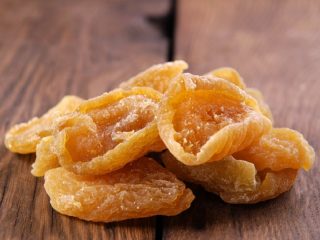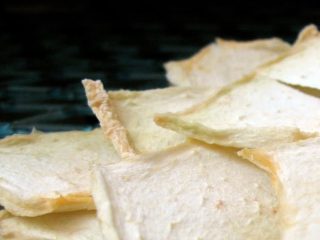Content
Dried kumquat is an exotic dried fruit, the properties of which few people know about. Meanwhile, it is interesting to understand what health benefits the product brings and how to use it correctly.
What kind of fruit is dried kumquat?
An unusual fruit called kumquat grows mainly in China, Japan, the Middle East and South America. The plant belongs to the citrus family; in appearance it is an evergreen tree with a rounded crown. Kumquat blooms with beautiful white flowers and bears small orange fruits - only about 3 cm in diameter.
Kumquat fruits are somewhat similar to oranges, although they are much smaller in size and have an elongated shape. The taste of kumquat is reminiscent of a sour tangerine, and you can eat not only the pulp of the fruit, but also their peel - sweetish with a slight bitterness.
Kumquat is found in stores not only fresh, but also dried.Dried kumquat is a common fruit that has been dried until almost all moisture has evaporated, but has significant health benefits.
Types of dried kumquat
Dried kumquat is found in several forms in stores. First of all, the product differs in color. The following variations exist:
- yellow — this color can be found most often, it is the most natural for naturally dried kumquat;
- orange, this variety is also common, dried fruits retain their natural color;
- red - real red dried kumquat may have a pale tint, but a rich, bright color may indicate the presence of dyes;
- green - most often the shade indicates tinting, but green dried kumquat can also be a hybrid of kumquat and lime, which actually has a grassy color.
In addition to the usual dried kumquat, there are also dried fruits - fruits dried whole with the peel. You can also find candied fruits in stores - they differ from dried kumquat and dried fruits in that they are first boiled in sugar syrup before drying. The benefits of the product remain quite high.
Why are dried kumquats different colors?
Dried fruit slices are found mainly in 4 shades - yellow, red, green and orange.
Yellow and orange colors are completely natural for the product, but red and green shades most often indicate the use of food coloring. Sometimes the green or red color is explained by the fact that the manufacturer does not offer a “pure” kumquat, but one of the many hybrid varieties.
Composition and nutritional value of dried kumquat
Dried yellow kumquat is as healthy as fresh citrus fruit, if not a little more. The fact is that when dried, almost all useful substances are preserved in the slices, and the concentration of some of them even increases. The product contains:
- vitamins C, E and B;
- manganese, zinc, copper and selenium;
- iron and calcium;
- pectins and fiber;
- essential oils - limonene, pinene, caryophyllene and many others;
- tannins;
- antioxidants;
- beta carotene.
From the point of view of nutritional value, the product consists mainly of carbohydrates; dried slices contain about 80 g of them. Proteins occupy about 3.8 g of the total volume, and fats are completely absent.
Calorie content of dried kumquat
The calorie content of dried kumquat per 100 g is about 283 kcal. Thus, dried slices are much more nutritious than fresh ones.
Calorie content of candied kumquat
Candied fruits have an even higher nutritional value. 100 g of sweet delicacy contains about 300 kcal.
What are the benefits of dried kumquat?
If we consider the composition of the product, it becomes clear that the beneficial properties and contraindications of dried kumquat are very diverse. The product is valued not only for its taste; if consumed regularly, it can bring the following benefits:
- normalize digestive processes due to the high fiber content;
- provide assistance with cramps and increased gas formation;
- cleanse the intestines, kumquat removes accumulated toxins and toxic substances from the body;
- improve blood composition and liver health;
- increase the body's immune resistance and strengthen vascular walls;
- has a beneficial effect on cardiac activity, dried fruit protects against strokes and heart attacks;
- lower cholesterol and prevent the development of cancer;
- eliminate symptoms of anemia and vitamin deficiency.
The benefit of kumquat lies in its beneficial effects on bone tissue and the nervous system. The product improves brain activity and helps strengthen memory; the beneficial properties of yellow dried kumquat have a rejuvenating effect on the body.
How to dry kumquats at home
The easiest way to get natural little lemons and dried kumquat fruits is to dry the citrus fruit slices yourself. This will preserve their beneficial composition and avoid eating artificially colored fruits.
At home, there are 3 methods of drying the product.
- In an electric dryer. Fresh fruits must be washed thoroughly, then cut in half, and then cut each half into thin slices. There is no need to peel the kumquat. Place the slices at small intervals on the grill of the appliance, set the temperature to 135 °C and turn on the dryer for 6 hours.
- In the oven. If you don’t have a special device, you can dry the slices in a regular oven. It is heated to 100-120 °C, and the chopped kumquat is laid out on a wire rack covered with parchment paper. You need to keep the preparations in the oven for about 5-8 hours, periodically checking readiness. If possible, the oven door can be left slightly ajar for better air circulation to prevent the slices from becoming too brittle.It is not recommended to place kumquats on a regular baking sheet; in this case, the drying process will be uneven on different sides.
- Naturally. It is most difficult to prepare a delicacy by natural air drying; the problem is that in conditions of high humidity, the kumquat more often rots than dries out. Basically, fans of “air” drying use 2 methods - thin slices of fruit are either hung on a string around the kitchen, or placed on a thin tray on a central heating radiator.
How to make candied kumquat at home
The beneficial properties of yellow dried kumquat are also preserved in candied fruits. The sweet product can also be prepared in your own kitchen yourself; it will take a lot of time, but the result will be very tasty.
The candied fruits are prepared as follows:
- a small amount of kumquat fruits are thoroughly washed, cut into slices and seeds removed;
- 500 g of granulated sugar is poured into 250 ml of water and boiled for several minutes until a thick syrup is obtained;
- Pour the prepared fruit slices into the boiling mixture, reduce the heat to medium and cook for another 10 minutes;
- remove from the stove and allow the candied fruits to cool completely naturally.
The main nuance of preparation is that the next day you will need to repeat the procedure and boil the candied fruits in syrup again for 10 minutes. The same must be done over the next 2 days.
After this, the almost finished delicacy is placed on a baking sheet covered with parchment and left in a well-ventilated place for a day. When the candied fruits dry, they will need to be placed in the oven for 5-6 hours, preheated to a low temperature - no more than 50 ° C. At the last stage of preparation, the sweet slices are sprinkled with powdered sugar and consumed with taste and benefit.
How to eat dried kumquat
The benefits and harms of dried kumquat fruits depend on the literacy of their use. First of all, you need to remember about the increased calorie content of dried kumquat fruits and not exceed the recommended daily dosages. It will be enough to eat only 6-8 fruits per day; if you exceed this norm, the nutritional properties of the product can negatively affect digestion and your figure.
You can eat dried kumquat as a separate treat, but it is often combined with other foods and drinks - the benefits do not decrease. For example, you can add dried slices to alcoholic and non-alcoholic cocktails to add an exotic aroma and taste.
Dried slices can be put into tea or crushed into powder and mixed with tea leaves. Kumquat is beneficial and delights with its pleasant taste when combined with honey - the product can be dipped in honey or molasses and consumed with tea or coffee.
How to store dried kumquat
The benefits and harms of dried kumquat are largely determined by its freshness - eating expired or spoiled delicacies is not recommended.
- Dried slices must be stored in a clean and dry container, away from sunlight and at low temperatures.
- It is best to put the product in a glass jar or plastic container and put it in the refrigerator - on the vegetable shelf.
- It is important to ensure that the humidity in the storage area is as low as possible; dried slices lose their benefits from contact with moisture and deteriorate faster.
If all conditions are met, the delicacy can retain its valuable properties and benefits for up to a year.
As for candied fruits, the optimal place to store them would be a jar with sweet syrup; in such conditions they can retain their benefits for up to 3 years. But in this case, the candied fruits will need to be constantly dried before use, which is not always convenient. Therefore, they are much more often stored in dry containers in the refrigerator at a temperature not exceeding 15 °C. When storing candied fruits, it is also important to ensure that the air humidity does not exceed 60%, and that the container with the product is not exposed to direct sunlight.
In the refrigerator, candied fruits can remain fresh and be beneficial for up to six months.
Conclusion
Dried kumquat is not only tasty, but also a very healthy exotic delicacy that can be prepared at home. With reasonable dosages, dried fruit can have a beneficial effect on the body and bring health benefits, the main thing is not to exceed the daily intake and give preference only to a natural product.












